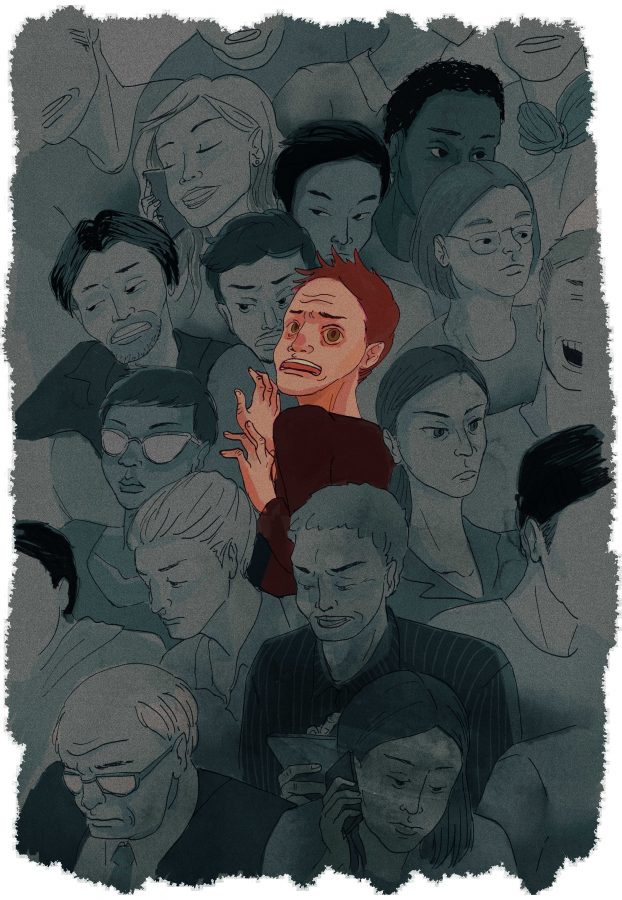In one of her AP Biology lectures last year, the teacher showed a photo of a beehive. Even though it was merely a picture on the screen, Jill* ’15 remembers breaking out in a cold sweat and choking on her breath. She tried to calm herself by taking deep breaths but eventually asked to go to the bathroom and stepped outside of the classroom for a few minutes.
“I couldn’t stay in there,” Jill said. “If I had stayed in that classroom with that picture on the board for any longer, I think I would have blacked out.”
Jill has trypophobia, a pathological fear of holes, and feels sick whenever she so much as thinks about an object such as a beehive. She is clinically diagnosed as having a phobia and sees a therapist to help lessen the effect that the phobia has on her life.
“I don’t really know where my phobia stems from,” Jill said. “I read online once that trypophobia is one of those odd phobias that doesn’t necessarily come about from a terrifying experience with something. Holes are just something ingrained into the person’s mind as dangerous.”
Phobias often develop as a result of bad experiences that happened in the past, family therapist Lori Sunkin M.A., (Michael ’19 and Sophia ’14)said.
“For example, if you were trapped in an elevator then you may develop a fear of elevators,” Sunkin said. “Or, if you were bitten by a dog as a young child, you may now be afraid of dogs. The best advice would be to talk to a professional who is experienced with these issues. Often times a cognitive behavioral therapist can be the most helpful.”
According to the Anxiety and Depression Association of America, 19 million Americans have specific phobias, and women are twice as likely to be affected as men. The association’s website states that an everyday anxiety is not a phobia and that an example of an everyday anxiety is “worrying about taking off in an airplane during a lightning storm.” An example of a phobia is, “turning down a big promotion because it involves air travel.” It also states that various methods, such as therapy, medication, meditation and acupuncture, can be used to treat or lessen the effects of specific phobias. The ability to completely overcome phobias depends on the person receiving treatment.
Luna* ’15 has claustrophobia, fear of having no way to escape, usually when in tight and enclosed spaces. Unlike Jill, Luna says that she has not encountered any circumstance in school that has triggered her phobia. She is also clinically diagnosed as having a phobia, and believes that her claustrophobia stems from one of her most terrifying experiences as a child while playing with her friends in preschool.
[instagram url=https://instagram.com/p/9cdH3qkClv/ hidecaption=true]
“Being little, we thought it was a good idea to zip someone inside of a duffel bag and I volunteered,” Luna said. “I don’t remember exactly what happened, but I ended up being stuck in that bag for at least 10 minutes. I distinctly remember thinking that I was going to die. Now that I’m older, I know that I probably wasn’t going to die from being zipped up into a duffel bag, but I still feel the fear from that experience whenever I’m in a small space.”
Luna says that when she goes to her therapy sessions, her therapist asks her to imagine a small and enclosed space and has her talk about how the image makes her feel.
“I go see my therapist maybe once every two weeks,” Luna said. “My phobia isn’t an immediate problem and it doesn’t affect my life on a daily basis. But I never know when a situation will arise where my phobia will be triggered, so I have a therapist to minimize the damage for that future point in time.”
Luna has never encountered anyone at Harvard-Westlake who has singled her out for her phobia.
“Claustrophobia is a widely-known phobia, so people seem to recognize it as a legitimate fear,” Luna said. “However, I think people with less common phobias have a harder time getting people to understand and accept the fact that they have this unreasonable fear of something that seems perfectly safe or relatively harmless. People who don’t have phobias don’t understand the extent of the fear. Sometimes the person with the phobia doesn’t either. It’s not really something that can be explained. It just is. All we can hope is that our peers will understand.”
Jill has run into problems with her peers as a result of her trypophobia. She was unable to fully resolve those problems.
“I’ve actually gotten into a pretty severe argument with someone because they thought that I was just trying to attract attention and that I was exaggerating my symptoms for pity,” Jill said. “He thought that I was just overreacting and didn’t actually believe me when I said that I felt like fainting whenever I saw something with holes.”
[instagram url=https://instagram.com/p/5gWef2QQ71/ hidecaption=true]
Jill says that she is no longer friends with the person she got into an argument with over her phobia because he refused to understand her condition and mocked her in front of their mutual friends for her “holey fear,” as he called it.
“I’m scared to tell people about my phobia now,” Jill said. “If someone I considered my friend was so unreceptive, other people that I know and trust could do exactly the same. It makes me extremely selective when making friends and limits me from having a lot of really close friends.”
Whenever the school has assemblies in Taper gymnasium, Tim* ’17 always enters late, sits near the front where people are the most spaced out, and is one of the first to leave. Tim has a mild form of agoraphobia, an anxiety disorder in which the sufferer fears or avoids what they consider to be dangerous or uncomfortable environments. In Tim’s case, he considers crowds to be dangerous. He believes that his phobia stems from an experience where he was separated from his mother as a young child in a crowded shopping mall.
[instagram url=https://instagram.com/p/9Mq0ZFqgnp/ hidecaption=true]
“My phobia is a bit difficult to deal within a school environment,” Tim said. “High school in general is very crowd oriented, but because I have an aversion to crowds, I can’t participate in as many school functions as I would like to.”
He says that rather than dealing with the symptoms of his phobia, he makes excuses to his friends about not attending athletic events.
“The only reason I can attend a normal high school is because my agoraphobia isn’t that bad,” Tim said. “Truthfully, it was a bit easier to deal with at the middle school than at the upper school, maybe because crowd mentality and crowd-based activities don’t really exist there. I’m also physically close to the people around me during upper school assemblies, while at the middle school, everyone had their own separate seat.”
Tim’s agoraphobia is mild, with symptoms that are relatively weak and easily disguised, but he still goes to see a therapist at least once every week.
“My phobia is easily triggered, and I can’t really avoid it, so I have to take a lot of extra measures to try and suppress the symptoms,” Tim said. “But I’m proud to say that it’s gotten to the point where I could be experiencing the symptoms of my phobia while sitting right next to someone, and that person wouldn’t notice. The symptoms of my agoraphobia were never really that bad compared to other peoples’ symptoms, so in that way, I’m thankful. I started out in an easier place than most other people that are affected by a phobia.”
All three students interviewed believe that a stigma exists about phobias.
“There’s sort of a stigma on steroids against having a phobia,” Jill said. “You’re judged because you have a phobia in the first place. And then on top of that, you have to go to a therapist to help treat the symptoms of that phobia, for which there is also a stigma. I end up not talking about [my phobia] because I don’t want to have to explain. And because I can’t trust all of the people around me to not judge me for my condition.”
Luna believes that if students were more educated on the subject of phobias, the stigma around having one could disappear.
“Most people just dismiss phobias because they see them as just another plain old fear,” Luna said. “If they could understand that phobias are irrational fears that are consuming and petrifying, there would be no stigma. Everyone is going to encounter at least one person in his or her life who has a phobia, so it makes sense to be educated on the subject.”
* Names have been changed.
































